Matt Rees's Blog - Posts Tagged "food"
In Nablus, the price is right
 I was tucking into a slice of qanafi at my favorite vendor in the Nablus casbah yesterday when a gang of Palestinian reporters and officials intruded on my guilty pleasure. This was at Aqsa Sweets, which readers of THE SAMARITAN'S SECRET will know as the place favored by the hero of my Palestinian crime novels Omar Yussef because it has a perfect blend of the cheeses of different Syrian and Palestinian goats in its qanafi (topped by semolina and drenched in syrup.)
I was tucking into a slice of qanafi at my favorite vendor in the Nablus casbah yesterday when a gang of Palestinian reporters and officials intruded on my guilty pleasure. This was at Aqsa Sweets, which readers of THE SAMARITAN'S SECRET will know as the place favored by the hero of my Palestinian crime novels Omar Yussef because it has a perfect blend of the cheeses of different Syrian and Palestinian goats in its qanafi (topped by semolina and drenched in syrup.)Mayor Adly Yaish was among the crowd. As he steamed his way through a plate of qanafi, he informed me that he, the Nablus region's governor, and the city's police chief were touring the casbah to draw attention to a law soon to come into effect that'll make it mandatory for vendors to show their prices. It's one of the economic reforms introduced by Prime Minister Salaam Fayyad, a Nablus native, intended to change the chaotic and often corrupt nature of the Palestinian economy.
A few minutes of jawboning with me about their hopes that my books will show the true Nablus (I think they do, but I didn't remind them that I write crime fiction), a forkful of qanafi raised for the cameras, and then the dignitaries were off into the narrow alleys in search of price tags.
I settled in to complete my lunch -- not a balanced diet, I know, but then my mother doesn't read this blog so I don't have to pretend to be watching what I eat. I washed it down with tea from a fellow who wandered in with an enormous pot and a cup of sugar in his apron.
Nablus is famous throughout the Arab world as the best place for qanafi. And Aqsa Sweets is the best qanafi in Nablus, thus the best in the Arab world and, obviously, in the world. You wouldn't know it. The place is floor to ceiling white ceramic tiles, as though they expected to hose it down at the end of the day. Up front there are two big burners with wide trays of orange qanafi. The surly fat kid who serves you slings it onto the table as though he thought frisbees were made of hot goat's cheese and syrup.
As for price, nothing's marked. For 4 shekels (a bit more than a dollar), you get 125 grams of qanafi. It doesn't look like much, but if you try to eat more than that, you'll either stagger out hoping never to see another piece of the stuff in your life, or you might just curl up and die in the corner of sugar-shock.
I went up Mount Gerizim, one of the two mountains whose steep sides form the valley in which Nablus lies. At the top I found my old pal Hosny Cohen, a Samaritan priest, in exultant mood. He's shifting his Samaritan Museum and Cultural Center to a bigger room.
"I've had two tour groups this morning, each of forty people," he said, leaning on his cane and pushing his fez forward neatly over his brow. "I don't have energy for you."
Then he proceeded to talk for an hour without stopping. When I was about to leave, he came after me and said: "I forgot to show you the 'mezuza' we put above the door..."
Which is why I can't help liking the Middle East.
Published on March 16, 2010 10:54
•
Tags:
adly-yaish, aqsa-sweets, crime-fiction, dessert, food, goats, hosny-cohen, mayor, nablus, palestine, palestinian, prime-minister, qanafi, salaam-fayyad, samaritans, syria, the-samaritan-s-secret
5 Places to Eat in Rome You Mustn't Miss
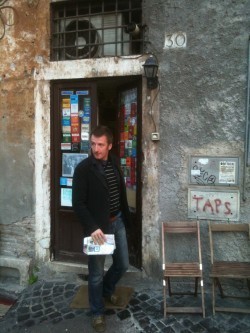 I've spent a lot of time in Rome over the years, including an extended period to research my novel about the great artist Caravaggio, A Name in Blood. Even a writer's got to eat, so here are the unmissable eateries of the eternal city.
I've spent a lot of time in Rome over the years, including an extended period to research my novel about the great artist Caravaggio, A Name in Blood. Even a writer's got to eat, so here are the unmissable eateries of the eternal city.1. Sora Margherita. Piazza delle Cinque Scole. Looks like a scene from Fellini's Roma, with rough decor, unrestrained atmosphere, and a focus on good food rather than "fine dining." Order anything, it's great. And don't leave food on your plate. The waitress will make you finish it.
2. San Crispino, Piazza della Maddalena and Via della Panneteria. Ice-cream is usually displayed in Rome in massive piles that are supposed to make it irresistible. At San Crispino, they keep the ice-cream under silver covers. But the taste truly is impossible to resist. The house flavor is honey, but the selection is always different. One day there'll be whisky, the next you'll find licorice. I've heard people complain that it's expensive. But as Martin Cruz Smith once said, "You don't sell a ride on a rocket shit for a dollar."
3. Il Fornaio. Via dei Baullari. Near Campo de'Fiori, this bakery/deli has excellent pizza and savories. But if you'd like a sugar-high that won't give you a gelato head-freeze, this is the place. The torta con ricotta e ciocollata is officially designated "the best thing in the world" by my five-year-old son.
4. Obika Mozzarella Bar. Campo de'Fiori, and Piazza Firenze. A chain that has expanded into the UK and USA. But there's nowhere to enjoy it that's better than Rome. A tasting menu of several different mozzarellas comes with a lesson from the staff about what makes a good mozzarella. (If you press it and thin white liquid comes out, it's fresh; if not, blaaah.) Also a great place for morning espresso and pastry.
5. Osteria della Quercia. Piazza della Quercia. In a tiny piazza opposite the Renaissance palazzo where the Council of State sits, in the shade of the oak tree from which it takes its name. A great place for traditional Roman food like deep fried cod and artichokes.
Published on June 18, 2013 01:36
•
Tags:
caravaggio, crime-fiction, food, historical-fiction, italy, rome
The Caravaggio masterpieces that make up the cover of historical novel
The cover of my Caravaggio novel, A Name in Blood, out now in UK paperback, is a composite of two works by the great Italian master....
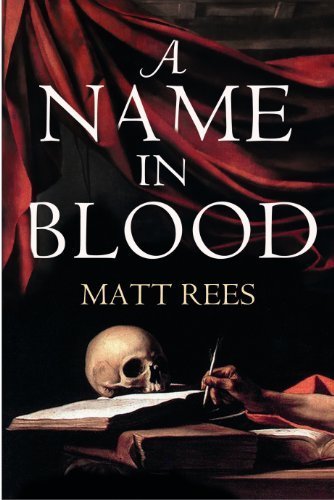
...There's the skull from St. Jerome Writing, painted in 1606 in Rome and still housed in that city at the Galleria Borghese...
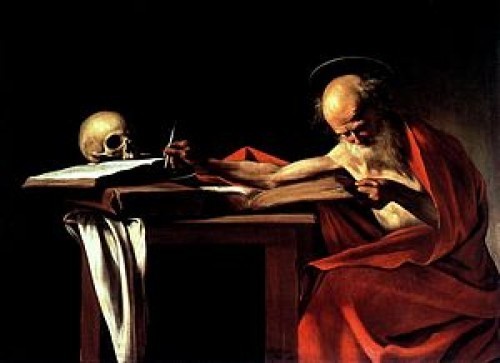
...and, completed in the same year but with distrous results for Caravaggio's career and mental health, The Death of the Virgin. Now in the Louvre, my novel's cover includes the luxurious canopy above the otherwise humble bed of Mary. It was a scandalous piece at the time. Usually the Virgin was portrayed ascending to Heaven. Here she's dying like any peasant woman.


...There's the skull from St. Jerome Writing, painted in 1606 in Rome and still housed in that city at the Galleria Borghese...

...and, completed in the same year but with distrous results for Caravaggio's career and mental health, The Death of the Virgin. Now in the Louvre, my novel's cover includes the luxurious canopy above the otherwise humble bed of Mary. It was a scandalous piece at the time. Usually the Virgin was portrayed ascending to Heaven. Here she's dying like any peasant woman.

Published on June 22, 2013 05:38
•
Tags:
caravaggio, covers, crime-fiction, food, historical-fiction, italy, rome
Daily Caravaggio: Love Victorious
 To mark the paperback publication of my Caravaggio novel A NAME IN BLOOD, I'm posting each of the paintings that appear in the book each day for the next month. In the novel I called this one "Love Victorious." (It's often known as "Amor Vincit Omnia.") Caravaggio painted it for Marchese Giustiniani. Onorio, Caravaggio's friend in the novel, calls it "the little Cupid smiling like he was game for anything." That appears to have been what Giustiniani thought too. When he showed visitors around his palazzo, he'd take them to this painting last, pull a cord to draw the curtain, and watch them gasp in shock and titilation. Is there an emoticon for that?...
To mark the paperback publication of my Caravaggio novel A NAME IN BLOOD, I'm posting each of the paintings that appear in the book each day for the next month. In the novel I called this one "Love Victorious." (It's often known as "Amor Vincit Omnia.") Caravaggio painted it for Marchese Giustiniani. Onorio, Caravaggio's friend in the novel, calls it "the little Cupid smiling like he was game for anything." That appears to have been what Giustiniani thought too. When he showed visitors around his palazzo, he'd take them to this painting last, pull a cord to draw the curtain, and watch them gasp in shock and titilation. Is there an emoticon for that?...
Published on August 08, 2013 03:17
•
Tags:
caravaggio, covers, crime-fiction, food, historical-fiction, italy, rome
Daily Caravaggio: Pope Paul V
 To coincide with the paperback publication of my Caravaggio novel A NAME IN BLOOD, I'm posting each of the paintings that appear in the book each day for the next month. Here's a nasty looking fellow, Pope Paul V. The Borghese Pope was new to the job when he chose Caravaggio to paint his portrait, and it's truly masterly. It doesn't back away from any of the bitterness and mendacity in his face. It reminds me, of course, of Pope Innocent X's reaction to the portrait Velazquez did of him half a century later: "It's too real," he said. By which he meant that the portrait, part of the Doria Pamphilij collection, didn't disguise his deviousness and anger as he might've expected. Here's what the pope's nephew Scipione says to Caravaggio about the portrait in my novel: "One gets the impression that he'll soon deliver some withering reproach." The portrait is privately held in the Palazzo Borghese in Rome. I've had the privilege to stand before it, and it's still more amazing as a life-size composition.
To coincide with the paperback publication of my Caravaggio novel A NAME IN BLOOD, I'm posting each of the paintings that appear in the book each day for the next month. Here's a nasty looking fellow, Pope Paul V. The Borghese Pope was new to the job when he chose Caravaggio to paint his portrait, and it's truly masterly. It doesn't back away from any of the bitterness and mendacity in his face. It reminds me, of course, of Pope Innocent X's reaction to the portrait Velazquez did of him half a century later: "It's too real," he said. By which he meant that the portrait, part of the Doria Pamphilij collection, didn't disguise his deviousness and anger as he might've expected. Here's what the pope's nephew Scipione says to Caravaggio about the portrait in my novel: "One gets the impression that he'll soon deliver some withering reproach." The portrait is privately held in the Palazzo Borghese in Rome. I've had the privilege to stand before it, and it's still more amazing as a life-size composition.
Published on August 09, 2013 01:17
•
Tags:
art-history, caravaggio, covers, crime-fiction, food, historical-fiction, italy, rome
Daily Caravaggio: Madonna of Loreto
 To coincide with the paperback publication of my Caravaggio novel A NAME IN BLOOD, I'm posting each of the paintings that appear in the book each day for the next month. At the center of the novel is Caravaggio's relationship with his model for this painting The Madonna of Loreto, which is in the Church of Sant'Agostino in Rome. Her name was Lena. Caravaggio's portrayals of her, as a Virgin who was also a poor woman living in a slum, were controversial -- even dangerous. Here he sees her at her door for the first time:
To coincide with the paperback publication of my Caravaggio novel A NAME IN BLOOD, I'm posting each of the paintings that appear in the book each day for the next month. At the center of the novel is Caravaggio's relationship with his model for this painting The Madonna of Loreto, which is in the Church of Sant'Agostino in Rome. Her name was Lena. Caravaggio's portrayals of her, as a Virgin who was also a poor woman living in a slum, were controversial -- even dangerous. Here he sees her at her door for the first time:At the burnt sienna towers of the Church of Sant’Atanasio, he cut onto the Via dei Greci, into the Evil Garden. The low morning sun struggled to drive the night from the narrow street. A pair of beggars knelt at the rough gray step of a small house, their fingers steepled, beseeching charity. The young woman in the doorway held a three-year-old boy on her hip. The boy was naked, half wrapped in a towel, as though the beggars’ call had interrupted his bathtime.
Caravaggio approached, watching the girl. The house was dark behind her. Daylight seemed to penetrate the street just for her, illuminating the eggshell clarity of her neck and chest. She crossed her bare feet and went up and down on her toes, pivoting from her hip to swing the boy as she listened to the old woman’s story. She let her head drop to her left so that her chin touched her collar bone, as she looked down upon the kneeling woman with compassion and reassurance.
He recognized her. The maid who had been cleaning the floor at del Monte’s palace. She’s turning her hips the opposite way to her shoulders, he noted, as though she knows about the contrapposto pose. She has found the grace of classical form without anyone having to teach her an academic term for it.
Caravaggio leaned against the wall by the threshold. The plaster had come away beside the chipped travertine of the doorway, exposing the brick beneath. He smiled and was surprised by how little calculation there was in his open look.
Published on August 11, 2013 02:28
•
Tags:
art-history, caravaggio, covers, crime-fiction, food, historical-fiction, italy, rome
Daily Caravaggio: Rest on the Flight into Egypt
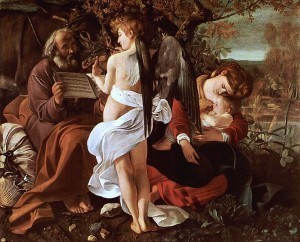 To coincide with the paperback publication of my Caravaggio novel A NAME IN BLOOD, I'm posting each of the paintings that appear in the book each day this month. The Rest on the Flight into Egypt is one of three Caravaggio masterpieces housed at the fabulous Doria Pamphilij Gallery in Rome. It's from about 1597 and is quite unlike his more characteristic later works. But it makes a great impression for the deeply human way in which he portrays relationship between the Virgin and her son. Here's Caravaggio recalling his work on the painting in my novel:
To coincide with the paperback publication of my Caravaggio novel A NAME IN BLOOD, I'm posting each of the paintings that appear in the book each day this month. The Rest on the Flight into Egypt is one of three Caravaggio masterpieces housed at the fabulous Doria Pamphilij Gallery in Rome. It's from about 1597 and is quite unlike his more characteristic later works. But it makes a great impression for the deeply human way in which he portrays relationship between the Virgin and her son. Here's Caravaggio recalling his work on the painting in my novel:
He barely knew what he had done at the time, a few years after arriving in Rome. A scene of the Holy Family succoured by the music of an angel as they fled the vengeful Herod, painted with the dreamy clarity of the Venetian school. But later, in the gallery of the Lady Olimpia Aldobrandini, he had recognized that his heart was imprinted on the canvas.
In that painting, exhausted by the journey, the Holy Mother rested her cheek on her baby’s head. The little Jesus, also half-asleep, picked at her mantle, as though he dreamed of feeding at her breast. Menica’s friend Anna had modelled for the Virgin. She had understood that her life as a cheap whore wouldn’t be a long one. Still she had faith that there might be an escape. Caravaggio had illustrated her hope and fear and acceptance in the drained, loving Virgin. The love of a mother who knew her son would be a sacrifice and was yet willing to undergo the hardships of the desert to preserve him for it. I saw all that in the face of a whore.
Anna had been dead a year now, at twenty-five, her skin wasted and scarred, her red hair dry and lustreless. He was with her at the end, and she had reminisced about the sixteen-year-old beauty he had painted as the Virgin. When she expired, he had dropped his head to her breast and shocked himself with his weeping. He had known many whores who had disappeared from the streets with little more than a shrug from him. Yet he had cried for Anna as though she had invented death, a malignant novelty displayed in a gallery which only he might view.
Published on August 12, 2013 01:43
•
Tags:
art-history, caravaggio, covers, crime-fiction, food, historical-fiction, italy, rome
Read a free chapter from my Caravaggio novel
A chapter from my Caravaggio novel A NAME IN BLOOD about one of the great Italian artist's most famous and controversial works.
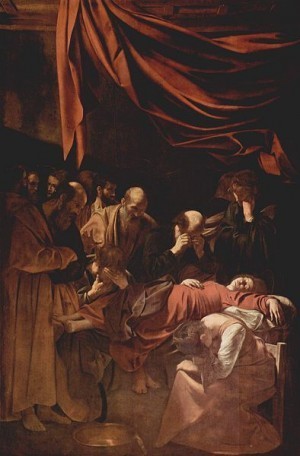 To coincide with the paperback publication of my Caravaggio novel A NAME IN BLOOD, I'm posting each of the paintings that appear in the book each day this month. The Death of the Virgin is truly one of the most magnificent works of art ever painted. These days it's at the Musee du Louvre. But when Caravaggio first revealed it in a Roman church, it caused a scandal and was soon removed. The controversy was caused by the portrayal of the Virgin as a peasant (with a whore used as the model) and as truly dead. Not ascending to heaven. Just dead. Here's one of the chapters from my novel where this painting is central. Caravaggio is summoned to the office of Cardinal del Monte, one of his patrons:
To coincide with the paperback publication of my Caravaggio novel A NAME IN BLOOD, I'm posting each of the paintings that appear in the book each day this month. The Death of the Virgin is truly one of the most magnificent works of art ever painted. These days it's at the Musee du Louvre. But when Caravaggio first revealed it in a Roman church, it caused a scandal and was soon removed. The controversy was caused by the portrayal of the Virgin as a peasant (with a whore used as the model) and as truly dead. Not ascending to heaven. Just dead. Here's one of the chapters from my novel where this painting is central. Caravaggio is summoned to the office of Cardinal del Monte, one of his patrons:
Del Monte scented himself with ambergris from the stomach of a sperm whale to counter the anticipated reek of the tavern on Caravaggio. He regretted what he had to tell him. He had seen the sorrowing soul of his old protégé in every inch of The Death of the Virgin. That Holy Mother would never rise to glory beside Her Son; she was dead, and those around her grieved like people without faith. When will he be here? the cardinal wondered. How many inns can there be for my footmen to search? He dabbed a few extra spots of the musk secretions of a deer along his lace collar and inhaled.
Caravaggio entered the study and weaved across the floor. It was evident that it cost him some effort to stay upright. His knee-length pantaloons were dusted with the lime innkeepers spread in their privies. Olive oil and gravy smeared his doublet. His whole body pulsated with tiny, seemingly uncontrollable motions. Yet his jaw was clamped so tight that del Monte thought he might hear the man’s teeth creaking like the boards of a ship in a storm. He caught a whiff of sweat as Caravaggio bent to kiss his ring. He inclined his nose to the musk on his collar.
‘I’m sorry to tell you that the Shoeless Fathers have rejected your painting, Maestro Caravaggio,’ he said.
Caravaggio grimaced and swayed. ‘Fine.’ He slurred even this briefest of utterances.
‘Maestro Baglione –’
A mumbled curse.
‘Maestro Baglione has been heard to say that you cover up your mistakes with shadows.’
A snort of contempt, his fist tight around the hilt of his sword. He used to have a servant to carry that for him, like a gentleman, del Monte thought. Now he wears it, as if at any moment he means to use it.
‘Cardinal Scipione has requested that I find a buyer for the rejected painting.’
‘Yeah?’ The artist’s lips barely moved.
I wonder he doesn’t belch at me. ‘I’ve some hopes of the Flemish fellow Rubens, who’s acting as agent for the Duke of Mantua in certain purchases. He’s an admirer of yours.’
To that, only a shrug and a queasy gulp, as if Caravaggio strove not to vomit in the cardinal’s study. Del Monte pursed his lips. At least he still has that much respect for me.
‘Michele, you understand the seriousness of what has happened?’
‘You mean the pregnant whore thing?’
‘Exactly.’
‘She’s not a whore. She’s not pregnant either. Not any more.’
‘The Carmelites – encouraged by certain artists – suggest that it would’ve been more appropriate to depict the Virgin carried heavenward by angels.’
‘When I see people flying, it’s usually because I’ve been too long in the tavern.’ Caravaggio stretched out his arms, flapped them and let them fall. His smile was forlorn.
‘For heaven’s sake, even Maestro Carracci painted the Virgin’s death as a joyful moment.’
‘I expect he regrets it. Anyway, Annibale’s good, but he’s not me.’
He has withdrawn from me before, del Monte thought, but never like this. Caravaggio was shut away behind this roughhouse façade, as if he were locked up with a courtesan for the weekend. Everything he painted aroused controversy – criticism of his work couldn’t be the only cause of this conduct. It must be that girl. ‘The art in our churches is not for our amusement. It’s supposed to be inspiring. If you don’t paint the Virgin ascending mystically into the sky, the worshippers at the church may fail to believe that it happened.’
‘The body doesn’t ascend. Haven’t you heard about such a thing as a soul? That’s what goes to heaven.’ Caravaggio closed his eyes, looking inward. He opened them suddenly, seeming to panic, scanning the room as if he feared his spirit had stolen away while he spoke. ‘What’s left is a bag of bones.’
Del Monte considered that Caravaggio may have deliberately presented himself in this condition, almost like a corpse, the living example of what he wanted people to see in The Death of the Virgin. A body, abused and wasting, meaning nothing, and a soul that made of itself the purest art.
‘I have, indeed, heard of the soul,’ the cardinal said. ‘I very much fear for yours.’
Read more about A NAME IN BLOOD by Matt Rees. Get the book.
 To coincide with the paperback publication of my Caravaggio novel A NAME IN BLOOD, I'm posting each of the paintings that appear in the book each day this month. The Death of the Virgin is truly one of the most magnificent works of art ever painted. These days it's at the Musee du Louvre. But when Caravaggio first revealed it in a Roman church, it caused a scandal and was soon removed. The controversy was caused by the portrayal of the Virgin as a peasant (with a whore used as the model) and as truly dead. Not ascending to heaven. Just dead. Here's one of the chapters from my novel where this painting is central. Caravaggio is summoned to the office of Cardinal del Monte, one of his patrons:
To coincide with the paperback publication of my Caravaggio novel A NAME IN BLOOD, I'm posting each of the paintings that appear in the book each day this month. The Death of the Virgin is truly one of the most magnificent works of art ever painted. These days it's at the Musee du Louvre. But when Caravaggio first revealed it in a Roman church, it caused a scandal and was soon removed. The controversy was caused by the portrayal of the Virgin as a peasant (with a whore used as the model) and as truly dead. Not ascending to heaven. Just dead. Here's one of the chapters from my novel where this painting is central. Caravaggio is summoned to the office of Cardinal del Monte, one of his patrons:Del Monte scented himself with ambergris from the stomach of a sperm whale to counter the anticipated reek of the tavern on Caravaggio. He regretted what he had to tell him. He had seen the sorrowing soul of his old protégé in every inch of The Death of the Virgin. That Holy Mother would never rise to glory beside Her Son; she was dead, and those around her grieved like people without faith. When will he be here? the cardinal wondered. How many inns can there be for my footmen to search? He dabbed a few extra spots of the musk secretions of a deer along his lace collar and inhaled.
Caravaggio entered the study and weaved across the floor. It was evident that it cost him some effort to stay upright. His knee-length pantaloons were dusted with the lime innkeepers spread in their privies. Olive oil and gravy smeared his doublet. His whole body pulsated with tiny, seemingly uncontrollable motions. Yet his jaw was clamped so tight that del Monte thought he might hear the man’s teeth creaking like the boards of a ship in a storm. He caught a whiff of sweat as Caravaggio bent to kiss his ring. He inclined his nose to the musk on his collar.
‘I’m sorry to tell you that the Shoeless Fathers have rejected your painting, Maestro Caravaggio,’ he said.
Caravaggio grimaced and swayed. ‘Fine.’ He slurred even this briefest of utterances.
‘Maestro Baglione –’
A mumbled curse.
‘Maestro Baglione has been heard to say that you cover up your mistakes with shadows.’
A snort of contempt, his fist tight around the hilt of his sword. He used to have a servant to carry that for him, like a gentleman, del Monte thought. Now he wears it, as if at any moment he means to use it.
‘Cardinal Scipione has requested that I find a buyer for the rejected painting.’
‘Yeah?’ The artist’s lips barely moved.
I wonder he doesn’t belch at me. ‘I’ve some hopes of the Flemish fellow Rubens, who’s acting as agent for the Duke of Mantua in certain purchases. He’s an admirer of yours.’
To that, only a shrug and a queasy gulp, as if Caravaggio strove not to vomit in the cardinal’s study. Del Monte pursed his lips. At least he still has that much respect for me.
‘Michele, you understand the seriousness of what has happened?’
‘You mean the pregnant whore thing?’
‘Exactly.’
‘She’s not a whore. She’s not pregnant either. Not any more.’
‘The Carmelites – encouraged by certain artists – suggest that it would’ve been more appropriate to depict the Virgin carried heavenward by angels.’
‘When I see people flying, it’s usually because I’ve been too long in the tavern.’ Caravaggio stretched out his arms, flapped them and let them fall. His smile was forlorn.
‘For heaven’s sake, even Maestro Carracci painted the Virgin’s death as a joyful moment.’
‘I expect he regrets it. Anyway, Annibale’s good, but he’s not me.’
He has withdrawn from me before, del Monte thought, but never like this. Caravaggio was shut away behind this roughhouse façade, as if he were locked up with a courtesan for the weekend. Everything he painted aroused controversy – criticism of his work couldn’t be the only cause of this conduct. It must be that girl. ‘The art in our churches is not for our amusement. It’s supposed to be inspiring. If you don’t paint the Virgin ascending mystically into the sky, the worshippers at the church may fail to believe that it happened.’
‘The body doesn’t ascend. Haven’t you heard about such a thing as a soul? That’s what goes to heaven.’ Caravaggio closed his eyes, looking inward. He opened them suddenly, seeming to panic, scanning the room as if he feared his spirit had stolen away while he spoke. ‘What’s left is a bag of bones.’
Del Monte considered that Caravaggio may have deliberately presented himself in this condition, almost like a corpse, the living example of what he wanted people to see in The Death of the Virgin. A body, abused and wasting, meaning nothing, and a soul that made of itself the purest art.
‘I have, indeed, heard of the soul,’ the cardinal said. ‘I very much fear for yours.’
Read more about A NAME IN BLOOD by Matt Rees. Get the book.
Published on August 14, 2013 03:31
•
Tags:
art-history, caravaggio, covers, crime-fiction, food, historical-fiction, italy, rome
Daily Caravaggio: The Madonna with the Serpent
My favorite painting ever and the key to my portrayal of Caravaggio's death in my novel about the great Italian artist.
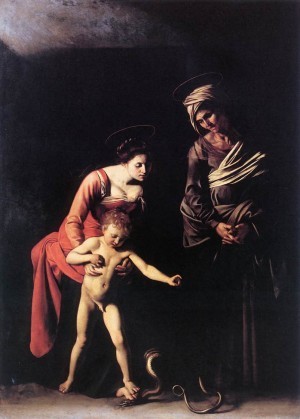 To coincide with the paperback publication of my Caravaggio novel A NAME IN BLOOD, I'm posting each of the paintings that appear in the book each day this month. This stunning painting has a number of names, The Madonna and Child with St. Anne or the Madonna dei Palafrenieri (after the papal grooms for whose chapel in St. Peters it was commissioned.) It's one of six (if I'm counting right) Caravaggios at the Galleria Borghese in Rome. For me it's the greatest of Caravaggio's works, and it plays a key role in my novel because it represents a moment in which the artist fell in love with the model for his Virgin. She was named Lena Antognetti and she's (no spoilers) very important to the plot of my book. Here's Caravaggio's point of view as he's working on the painting:
To coincide with the paperback publication of my Caravaggio novel A NAME IN BLOOD, I'm posting each of the paintings that appear in the book each day this month. This stunning painting has a number of names, The Madonna and Child with St. Anne or the Madonna dei Palafrenieri (after the papal grooms for whose chapel in St. Peters it was commissioned.) It's one of six (if I'm counting right) Caravaggios at the Galleria Borghese in Rome. For me it's the greatest of Caravaggio's works, and it plays a key role in my novel because it represents a moment in which the artist fell in love with the model for his Virgin. She was named Lena Antognetti and she's (no spoilers) very important to the plot of my book. Here's Caravaggio's point of view as he's working on the painting:
 To coincide with the paperback publication of my Caravaggio novel A NAME IN BLOOD, I'm posting each of the paintings that appear in the book each day this month. This stunning painting has a number of names, The Madonna and Child with St. Anne or the Madonna dei Palafrenieri (after the papal grooms for whose chapel in St. Peters it was commissioned.) It's one of six (if I'm counting right) Caravaggios at the Galleria Borghese in Rome. For me it's the greatest of Caravaggio's works, and it plays a key role in my novel because it represents a moment in which the artist fell in love with the model for his Virgin. She was named Lena Antognetti and she's (no spoilers) very important to the plot of my book. Here's Caravaggio's point of view as he's working on the painting:
To coincide with the paperback publication of my Caravaggio novel A NAME IN BLOOD, I'm posting each of the paintings that appear in the book each day this month. This stunning painting has a number of names, The Madonna and Child with St. Anne or the Madonna dei Palafrenieri (after the papal grooms for whose chapel in St. Peters it was commissioned.) It's one of six (if I'm counting right) Caravaggios at the Galleria Borghese in Rome. For me it's the greatest of Caravaggio's works, and it plays a key role in my novel because it represents a moment in which the artist fell in love with the model for his Virgin. She was named Lena Antognetti and she's (no spoilers) very important to the plot of my book. Here's Caravaggio's point of view as he's working on the painting:
He had never been so happy. Something had become free in him. He ascribed it to the liveliness the Antognettis brought to his studio and his love for them. The way Lena tickled the boy when Caravaggio wasn’t watching, the boy’s fascination with the painter’s mirrors, the old woman’s pride in the talent of her daughter’s man. He could see his own contentment in the paint too, feel it in his brush. On the canvas, every fold in the women’s skirts seemed entirely true to him. He wanted to step into the painting. He knew the Madonna would welcome him. In spite of all the wrong he had done in his life, she would draw his head to her breast, just as Lena did every night.
Published on August 15, 2013 02:07
•
Tags:
art-history, caravaggio, covers, crime-fiction, food, historical-fiction, italy, rome
Daily Caravaggio: Seven Acts of Mercy
Caravaggio's Naples masterpiece
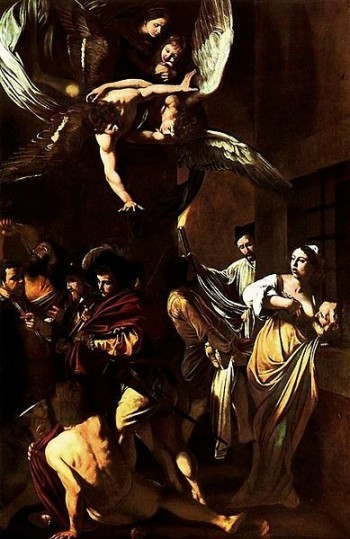 The great Italian artist Caravaggio painted The Seven Works of Mercy (or Our Lady of Mercy, as it's actually called) in Naples in 1607. He was on the run with a price on his head. He was, of course, the perfect character for a historical thriller, because he was producing masterpieces while trying to keep a step ahead of the men who wanted him dead. To coincide with the paperback publication of my Caravaggio novel A NAME IN BLOOD, I'm posting each of the paintings that appear in the book each day this month along with a snippet from the novel. The church where the painting is housed is on a very busy street the medieval district. The street noise is very much part of the painting, which shows a crowded Naples scene. I imagined Caravaggio right there:
The great Italian artist Caravaggio painted The Seven Works of Mercy (or Our Lady of Mercy, as it's actually called) in Naples in 1607. He was on the run with a price on his head. He was, of course, the perfect character for a historical thriller, because he was producing masterpieces while trying to keep a step ahead of the men who wanted him dead. To coincide with the paperback publication of my Caravaggio novel A NAME IN BLOOD, I'm posting each of the paintings that appear in the book each day this month along with a snippet from the novel. The church where the painting is housed is on a very busy street the medieval district. The street noise is very much part of the painting, which shows a crowded Naples scene. I imagined Caravaggio right there:
 The great Italian artist Caravaggio painted The Seven Works of Mercy (or Our Lady of Mercy, as it's actually called) in Naples in 1607. He was on the run with a price on his head. He was, of course, the perfect character for a historical thriller, because he was producing masterpieces while trying to keep a step ahead of the men who wanted him dead. To coincide with the paperback publication of my Caravaggio novel A NAME IN BLOOD, I'm posting each of the paintings that appear in the book each day this month along with a snippet from the novel. The church where the painting is housed is on a very busy street the medieval district. The street noise is very much part of the painting, which shows a crowded Naples scene. I imagined Caravaggio right there:
The great Italian artist Caravaggio painted The Seven Works of Mercy (or Our Lady of Mercy, as it's actually called) in Naples in 1607. He was on the run with a price on his head. He was, of course, the perfect character for a historical thriller, because he was producing masterpieces while trying to keep a step ahead of the men who wanted him dead. To coincide with the paperback publication of my Caravaggio novel A NAME IN BLOOD, I'm posting each of the paintings that appear in the book each day this month along with a snippet from the novel. The church where the painting is housed is on a very busy street the medieval district. The street noise is very much part of the painting, which shows a crowded Naples scene. I imagined Caravaggio right there:
Outside the taverns, Neapolitans lifted long handfuls of maccheroni and lowered it into their mouths, their heads cast back as if they might feed it directly through their throats and into their stomachs like sword swallowers. The wailing of the zampogna cut through the noise of the crowd, a shrill melody and a low bagpipe drone that reverberated in his very ribcage.
He slipped into a pew before the altar of the Pio Monte. Lena gazed on him with compassion. She was Our Lady of Mercy, the Virgin he had painted surveying the crowded streets of Naples.
Published on August 18, 2013 03:34
•
Tags:
art-history, caravaggio, covers, crime-fiction, food, historical-fiction, italy, rome



